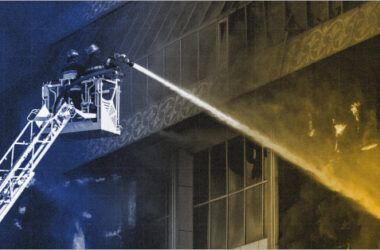In the dynamic sphere of Indian business, safeguarding against the devastating impact of fires is paramount for ensuring continuity and resilience. With the ever-present risk of fire hazards lurking in workplaces, understanding the intricacies of Fire Insurance becomes indispensable for businesses. This article serves as a comprehensive guide, delineating a step-by-step guide to purchasing Fire Insurance tailored for Indian businesses. This guide looks to empower business owners and decision-makers with the insights necessary to make informed choices in safeguarding their assets.
Steps to Take for Purchasing Fire Insurance for Your Indian Business
To help Indian businesses navigate the process of purchasing Fire Insurance effectively, here’s a step-by-step guide:
Step 1: Assess Your Risk Profile
The first step in purchasing Fire and Burglary Insurance for your business is to assess your risk profile comprehensively. This involves identifying potential fire hazards within your premises, evaluating the nature of your business operations, and understanding the specific risks associated with your industry. For instance, a manufacturing facility may face higher fire risks due to the presence of flammable materials and machinery. On the other hand, a retail establishment may be vulnerable to fires caused by electrical faults or arson. Conducting a thorough risk assessment will help you determine the type and level of coverage required to adequately protect your business against fire-related risks.
Step 2: Determine Your Coverage Needs
Once you have assessed your risk profile, the next step is to determine your coverage needs. Fire and Burglary Insurance Policies typically offer coverage for property damage, business interruption, and liability arising from fire and burglary-related incidents. Property damage coverage reimburses the cost of repairing or replacing damaged assets, including buildings, equipment, and inventory, in the event of a fire. Business interruption coverage compensates for lost income and operating expenses incurred during the period of business disruption caused by a fire. Additionally, liability coverage protects your business against claims for bodily injury or property damage caused to third parties as a result of a fire on your premises. Assessing your coverage needs will help you tailor your Fire Insurance Policy to suit your business requirements effectively.
Step 3: Shop Around for Quotes
With a clear understanding of your risk profile and coverage needs, the next step is to shop around for Fire Insurance quotes from reputable insurers in India. It’s essential to obtain quotes from multiple insurers to compare coverage options, premiums, deductibles and policy terms. While cost is an important factor to consider, it’s equally crucial to prioritize coverage quality and insurer reliability. Look for insurers with a strong financial standing, a track record of timely claims settlement, and favorable customer reviews. Additionally, consider seeking recommendations from industry peers or consulting with insurance brokers. They will help you identify reputable insurers that specialize in providing Fire and Burglary Insurance for your business.
Step 4: Review Policy Terms and Conditions
Before finalizing your Fire Insurance Policy, carefully review the terms and conditions outlined in the policy document. Pay close attention to coverage limits, exclusions, deductibles, and any additional endorsements or riders included in the policy. Exclusions typically vary depending on the insurer and may include risks such as arson, acts of terrorism, or intentional damage. It’s essential to understand the extent of coverage provided by the Fire and Burglary Insurance Policy and ensure that it aligns with your business needs and risk tolerance. If you have any questions or concerns about the policy terms, don’t hesitate to seek clarification from your insurer or insurance broker. This way, you can avoid any misunderstandings or surprises in the event of a fire-related claim.
Step 5: Customize Your Coverage
Depending on your business requirements, you may need to customize your Fire Insurance coverage to provide additional protection against specific risks or enhance existing coverage limits. For example, if your business operates in a high-risk area prone to natural disasters such as wildfires or earthquakes, you may want certain endorsements for natural disaster coverage. Similarly, if you have valuable assets or specialized equipment that require higher coverage limits, you can opt for increased property damage limits. You may also look for additional coverage options to ensure adequate protection. By working closely with your insurer or insurance broker, you can tailor your Fire Insurance Policy to address the unique needs and vulnerabilities of your business effectively.
Step 6: Implement Fire Prevention Measures
While Fire Insurance provides financial protection against fire-related risks, preventing fires from occurring in the first place is always the best strategy. Implementing robust fire prevention measures within your business premises can help reduce the likelihood of fires and minimize the potential damage they can cause. This may include installing fire detection and suppression systems and conducting regular maintenance of electrical systems and equipment. You can also consider enforcing smoking policies and providing employee training on fire safety protocols and evacuation procedures. By investing in proactive fire prevention measures, you can mitigate fire risks. You can also potentially qualify for lower insurance premiums by demonstrating reduced risk to insurers.
Step 7: Maintain Regular Communication with Your Insurer
Once you have purchased Fire Insurance for your Indian business, it’s essential to maintain regular communication with your insurer. This way, you can stay informed about any changes or updates that may affect your coverage. This includes notifying your insurer of any significant changes to your business operations, such as expansion or relocation. You can also communicate regarding updating your coverage to reflect any changes in your risk profile. Additionally, in the event of a fire-related incident, promptly notify your insurer and initiate the claims process to ensure timely assistance and claims settlement. By fostering a proactive and transparent relationship with your insurer, you can ensure that your Fire Insurance coverage remains current, relevant, and responsive to your evolving business needs.
Conclusion:
We can conclude by saying that purchasing Fire Insurance for your Indian business is a critical aspect of risk management that requires careful consideration and planning. By following this step-by-step guide, you can navigate the process of purchasing Fire Insurance effectively. By taking proactive steps to protect your business against fire-related risks, you can safeguard your assets and ensure business continuity. This way, you can achieve peace of mind knowing that your business is adequately protected against unforeseen fire hazards.
FAQs
How do I determine the amount of Fire Insurance coverage needed for my business?
Determining the appropriate amount of Fire Insurance coverage for your business involves a thorough assessment of various factors to ensure adequate protection against potential losses. Firstly, evaluate the value of your business property, including buildings, equipment, inventory, and other assets. This will help you determine the cost of replacement or repair in the event of fire damage. Consider factors such as the age and condition of the property, as well as any improvements or renovations made. Additionally, assess the business’s revenue and financial stability to gauge the potential impact of a fire-related interruption on operations. Calculate the estimated cost of business interruption, including lost income, extra expenses, and ongoing operational costs during the restoration period. Furthermore, consider any regulatory or contractual requirements that may dictate minimum insurance coverage levels. Collaborating with a qualified insurance professional or risk management advisor can provide valuable insights and guidance. He or she will help you determine the optimal level of Fire Insurance coverage tailored to your business’s unique needs and risk profile.
Is it necessary to conduct a risk assessment before purchasing Fire Insurance for my business?
Yes, conducting a risk assessment before purchasing Fire Insurance for your business is essential. A risk assessment helps identify potential fire hazards specific to your business premises and operations. This allows you to take proactive measures to mitigate these risks. It also enables you to determine the appropriate coverage needed based on the identified risks. Thus, ensuring that your insurance policy adequately protects your business assets and liabilities in the event of a fire-related incident. You can also minimize the likelihood of unexpected losses or disruptions to your business operations.
What steps can I take to prevent fires in the workplace and reduce insurance costs?
To prevent fires in the workplace and reduce insurance costs, several proactive steps can be taken. Firstly, implementing a robust fire prevention and safety program is essential. This can include regular inspections of electrical systems, machinery, and fire suppression equipment. Ensuring proper storage of flammable materials and chemicals, along with clear labeling and handling procedures, can also mitigate fire risks. Conducting employee training on fire safety protocols, evacuation procedures, and the proper use of fire extinguishers is crucial to fostering a culture of awareness and preparedness. Additionally, establishing clear smoking policies, maintaining clean and clutter-free workspaces, and promptly addressing any fire hazards or potential ignition sources can further enhance workplace safety. By prioritizing fire prevention measures and demonstrating a commitment to safety, businesses can not only protect their employees and assets but also potentially qualify for lower insurance premiums by demonstrating reduced risk to insurers.








